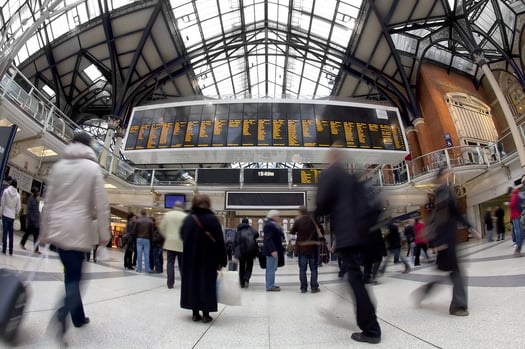How often do you think about the space in your immediate environment?
The probability is that you rarely consider the space around you until there's a significant impact either negative or positive that affects you.

When you consider how your senses can be stimulated within your local environment you may immediately think of light, smell or taste and forget to consider how the amount of space around makes you feel.
I need my space!
There is a direct relationship between the environment and how it can affect the behaviour of its inhabitants. Proxemics is the study of proximity of space and personal privacy within your immediate surroundings.
When was the last time you felt that your personal space had been invaded?
-
On a commute to work by train or bus?
-
Crowding in a public space?
-
Or maybe in a queue at the shops?
-
How did it make you feel?

In public we all require a certain amount of personal privacy within our immediate surroundings to make us feel at ease within the local environment, thus allowing us to physically and mentally relax. If a stranger were to take a step too close to us within our zone of discomfort we would feel as though our personal territory has been invaded. Violation of our space can lead to stress, anxiety and anger.
Try this out and see how you are emotionally affected when your own personal space is disturbed. You may need some help from some space invaders within your vicinity.
Let’s see if the results from your test are the same as the findings from Edward Hall’s studies.
Edward Hall found that we have several psychological “space bubbles” surrounding us that represent physical distances between us and others.
-
Intimate Space – which is measured from touching another person with our body to roughly 60 centimetres. We normally only allow close family members, friends, lovers and pets in this space.
-
Personal Space – starts from arm’s length and ending about 120 centimetres away. This space is reserved for friends, colleagues and group discussions.
-
Social Space – is measured from 120 centimetres to 300 centimetres. We will allow strangers into this zone.
-
Public Space – is measured from 300 centimetres and onwards. This space is usually when we are in an open forum where there is plenty of public space.
So how did you get on with people entering your immediate space bubbles?
The probability is that you felt uncomfortable with the proximity of people within your intimate zone - (not our term!)
Aren't we all hungry for space?
In 1962 John B Cahoun also conducted proximity research with the use of rats within a sealed enclosure. The study observed the density of a growing population and how it psychologically affected the inhabitants.
Cannibalism followed the increase in aggression and Cahoun called the downward spiral of behaviours as “a behavioural sink”.The fight or flight scenario arose in the rats as a result. But as you can imagine under test conditions it was impossible for the rats to escape so the only option was to fight.
The studied revealed that the lack of space and the breeding populace of rats led to:
-
unwanted social contact,
-
stress
-
and violence.
Now I’m not suggesting that within a similar environment that humans would break out into a rage of cannibalistic behaviours, but it is certainly worth comsderimg the findings of the experiment when planning the design of a space to be used by a large number of people for long periods of time.
Children spend about 6 hours a day, five days a week together in close quarters where their attention needs to be focused without distraction.
Careful consideration into interior spaces can positively enhance the wellbeing of its users and lead to increased engagement and productivity.
Throughout the school year the majority of school classrooms across the country will emulate the traditional formation that we all experienced whilst at school, rows and rows of close desks facing the front to focus our attention solely on the teacher.
Space in classrooms needn't be based on regimented Victorian age classrooms and teaching spaces, instead with careful space planning they can become innovative, fun and state of the art learning spaces.
A classroom that has been designed to work for the shape and style of the room will allow children and teachers the space and the flexibility to move within the learning environment. Planned classroom spaces can provide areas for pupils to collaborate and creatively express themselves free from overcrowding and clutter.
Effective room flow and furniture arrangement will allow all children to have a better view of the board or teacher (or maybe even the view outside) and provide teachers with the ability to move easily throughout the class without rearranging furniture during the school day.
School is no longer about sitting in close rows and receivng a lecture for the majority of the lesson. Research and reality has shown that children learn better through interaction and experience.
The pupils need to talk to one another and collaborate to form strong learning relationships in comfortable surroundings where they can relax and focus on the task in hand. To reflect new learning techniques, the teaching environment requires a radical transformation from rows and groups of desks to a classroom specific design reflecting world outside and different ways in which we all learn.
Google has been successful in creating a working environment such as this. Their playful work spaces help their teams to work together effectively within a spacious and playful environment. Fun and play go hand in hand with children and can be an effective learning motivator.
How can we create a successful learning space?
Google’s laissez faire working environment may not be practical for everyday classrooms as teachers often still need to lead activities, but children’s desks should not feel like a prison.
A careful balance is required with a well thought out design that is vital for flexibility and ease of movement for all.
Children should not feel as though their personal space has been invaded within a squashed and uncomfortable environment.
As we have discovered this will only lead to distraction, stress and the decreased task performance.
Well designed classroom space will promote feelings of wellbeing that will allow positive interactions, focus and improved learning within a comfortable and fun learning environment. There is no one size fits all solution to classroom layout.
So if you ever see one child gnawing on the leg of another, remember the rats and give us a call
.

